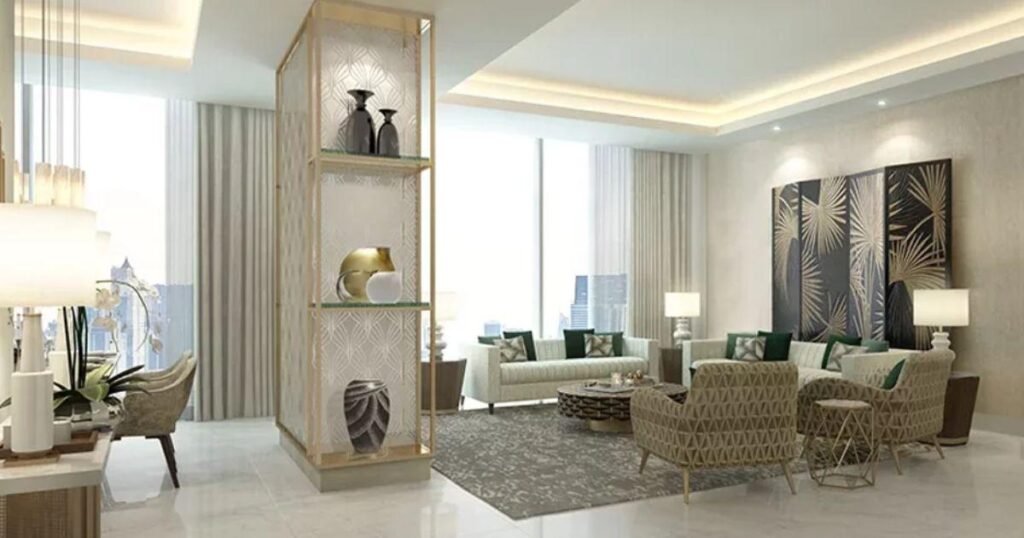The layout of furniture in a space is one of the most critical aspects of interior design. It significantly affects the functionality, flow, and overall aesthetic of a room. A well-thought-out furniture arrangement can transform a space, making it more inviting and comfortable while also enhancing the style. This article will delve into how furniture layout impacts interior design, offering tips and insights for creating an optimal arrangement in your home.
Understanding Furniture Layout
Before diving into specific strategies, it’s essential to understand what furniture layout entails. Furniture layout refers to the strategic arrangement of furniture pieces within a room. This involves not just placing items, but also considering their size, shape, style, and how they interact with one another and the room’s architecture. A successful layout enhances both the functionality and visual appeal of a space.
1. Defining Zones and Purpose
One of the primary impacts of furniture layout is its ability to define different zones within a space. In open-concept living areas, for example, strategically placing furniture can help create distinct functional areas, such as:
- Living Area: Use sofas, chairs, and coffee tables to define a cozy conversation area. Arrange seating to encourage interaction, facing each other or angled towards a focal point like a fireplace or TV.
- Dining Area: A dining table can anchor a separate zone, especially when paired with appropriate lighting. Positioning it close to the kitchen enhances functionality, making serving and clean-up more efficient.
- Work or Study Area: In multipurpose spaces, placing a desk in a corner or near a window can establish a home office zone without sacrificing the overall flow of the room.
By delineating areas, you create a more organized and functional space. Each zone can serve its purpose without feeling cluttered or chaotic.
2. Creating Flow and Accessibility
A well-planned furniture layout promotes ease of movement within a space. The arrangement should facilitate traffic flow, allowing people to navigate easily between different areas without obstruction. Consider the following tips to enhance flow:
- Clear Pathways: Ensure that there are clear pathways between furniture pieces. For example, maintain at least 18 inches of space between sofas and coffee tables to allow for easy movement.
- Functional Grouping: Group furniture based on its use. For instance, keep dining chairs close to the table, and position seating in the living room around a central coffee table. This creates a natural flow and enhances the usability of each area.
- Visual Pathways: Use furniture to guide the eye throughout the room. Arranging pieces at angles or using rugs can help create visual pathways that encourage exploration and flow.
3. Enhancing Aesthetic Appeal
The layout of furniture also plays a crucial role in the visual impact of a space. A thoughtful arrangement can elevate the overall design by highlighting key features and creating a cohesive look. Here are some ways to enhance aesthetics through furniture layout:
- Focal Points: Position furniture to draw attention to architectural features, artwork, or scenic views. For example, arrange seating to face a fireplace or a large window, creating a natural focal point.
- Balance and Symmetry: Strive for balance in your arrangement. This can be achieved through symmetry—using matching pairs of chairs or lamps on either side of a sofa—or asymmetry by balancing larger pieces with smaller accessories.
- Layering: Layering furniture and decor adds depth to a space. For instance, use rugs to define seating areas, and place side tables or ottomans within reach to create a layered, inviting look.
4. Maximizing Space and Functionality
The impact of furniture layout is particularly significant in smaller spaces, where maximizing functionality is essential. A strategic arrangement can make a room feel more spacious while ensuring that it meets your needs. Consider these approaches:
- Multi-Functional Furniture: Invest in furniture that serves multiple purposes, such as a sofa bed or a coffee table with storage. Position these pieces strategically to enhance their functionality without overcrowding the room.
- Vertical Space: Utilize vertical space for storage to keep the floor area open. Tall bookshelves or wall-mounted cabinets can provide storage without consuming precious floor space.
- Light and Airiness: Arrange furniture to allow natural light to flow freely through the room. Avoid heavy, bulky pieces that block light or make the space feel cramped. Opt for lighter colors and transparent materials to create an airy atmosphere.
5. Reflecting Personal Style
A thoughtfully planned furniture layout not only enhances functionality but also reflects your personal style. The arrangement of furniture can convey a specific design aesthetic, whether modern, traditional, eclectic, or minimalist. Here’s how to let your style shine through:
- Signature Pieces: Incorporate standout furniture pieces that embody your style. A unique coffee table or an eye-catching sofa can serve as a conversation starter and focal point.
- Mix and Match: Don’t be afraid to mix different styles and textures. An eclectic layout can add character and warmth to a space. Just ensure that the arrangement feels cohesive, even with diverse pieces.
- Personal Touches: Add accessories, artwork, and decor that resonate with you. Position these items within the furniture layout to create a harmonious and personalized space.
6. Adapting to Change
One of the benefits of a flexible furniture layout is its adaptability to change. As lifestyles evolve, so do the needs for different spaces. Consider the following:
- Rearrangement: Don’t hesitate to rearrange furniture periodically. A new layout can refresh a room, improving its functionality and aesthetic without requiring new purchases.
- Seasonal Adjustments: Adjust your layout seasonally, moving furniture to make the most of natural light during winter or to create an outdoor flow in summer.
- Lifestyle Changes: As your life circumstances change—whether welcoming a new family member or transitioning to remote work—reassess your layout to ensure it continues to meet your needs.
Conclusion
The layout of furniture plays a pivotal role in interior design, influencing the functionality, flow, and overall aesthetic of a space. Interior designers in Chennai understand that by mastering the principles of furniture arrangement, you can create areas that not only serve their purpose but also enhance your home’s beauty and comfort. Whether you’re designing a new space or reimagining an existing one, focusing on furniture layout is key to achieving a harmonious and inviting environment. Remember, a well-considered furniture arrangement is an investment in both style and functionality that pays off in everyday living.






More Stories
MindfulMe: Your Go-To App for Mental Health
The Luxe Hoodie Combining Sophistication
Can Quitting Smoking for One Year Help Recover from Severe Emphysema and Chronic Bronchitis?